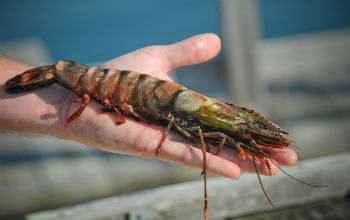Reprinted from the Tideland News
BEAUFORT — It’s official: the influx of Asian tiger shrimp into N.C. waters, the rest of the South Atlantic coast and the Gulf of Mexico is significantly worrisome, if not downright frightening.
Supporter Spotlight
Dr. James Morris, a marine ecologist at the National Oceanic and Atmospheric Administration’s Center for Coastal Fisheries and Habitat Research in Beaufort, said recently that a report from the U.S. Geological Survey indicated that the numbers of the jumbo shrimp, which can grow as long as 13 inches, increased tenfold between 2010 and 2011.
“If that trend continues this year, we’ll be able to say we’re certain this is truly an ‘invasion,’ that these shrimp are self-reproducing, not just a one-time pulse,” Morris said. “It’s looking serious. If it keeps up, we’ll reach a ‘point of no return.’ There could be significant implications, including possible disruptions in the food web.”

The number of tiger shrimp caught by U.S. fishermen increased tenfold in a year. Photo: Marc Hall, N.C. State University |
The USGS survey notes that watermen brought in only 32 of the Asian shrimp in 2010, but caught 331 in 2011. Experts say the population is probably far higher than those numbers indicate, as fishermen generally report sightings and catches less often as they become more familiar with the species.
The tiger shrimp first came to widespread attention in North Carolina late last summer, when Sam Meadows, a commercial fisherman in Cedar Point in Carteret County, caught about 35 in the Cape Fear region and off South Carolina, between Georgetown and Charleston. Others were caught in Pamlico Sound.
Supporter Spotlight
Meadows ate one back then.
“I prefer our domestic shrimp, maybe just because that’s what I’m used to,” he said. “But it was good; it tasted like shrimp. And if somebody who didn’t know our shrimp ate one, he probably wouldn’t notice anything, except that it’s a little tough. And believe me, it’s a meal.”
Some of the crustaceans, which to the untrained eye look more like lobster than the shrimp species native to North Carolina waters, were more than a foot long. And they’re black-and-white striped, hence the tiger name.
If the population is growing because of reproduction, not because the shrimp are moving in from other waters, Morris said there is almost no chance the species could be eradicated.
“I don’t think it would be possible, not in my opinion,” he said. “We just don’t have the biotechnology tools to do that, like we do with ‘pests’ in agriculture. I always like to be optimistic, and maybe those tools could be developed, but it would many years and a lot of money for research.”
No one, Morris said, can be sure yet how the tiger shrimp will affect North Carolina’s prized native shrimp. Millions of pounds are caught and sold each year, and Morris called the population “robust and dynamic.” But, he added, shrimp are an annual crop, and the population is heavily dependent upon environmental factors, such as rainfall. Shrimp like high salinity levels, and heavy rainfall in the spring can decrease salinity and affect the shrimp crop significantly.
In other words, if the tiger shrimp reproduce well and the native shrimp don’t, there’s no telling what could happen; the answer, Morris said, will come, if it comes at all, with continued research and ecological impact studies.
In the end, we all might do well to learn to love our new shrimp.
As with the impact, the question of exactly how the tiger shrimp got here is, for now, unanswered. Though there is speculation it might have arrived via ocean currents after being released from aquaculture operations in the Caribbean or in ballast water in a ship, Morris said the ultimate answer might come from genetic research, using DNA.
Since the USGS announced the results of its comparative surveys of 2010 and 2011 tiger shrimp catches, headlines in some media have been alarming. One, for example, brought to mind Japanese horror films about Godzilla and other mutant creatures: “Giant Cannibal Tiger Shrimp Are Taking Over U.S. Waters.”

Dr. James Morris |
Morris said it’s true that the tigers do eat other shrimp, but so do other shrimp, not to mention fish. The difference is the Asians are larger and eat more.
“They are no more carnivorous than other shrimp,” Morris said. “But if those kinds of headlines catch the eye and then people read the stories and learn more about invasive species and why they are bad, then I don’t really mind. Maybe this will help people learn a lesson.”
Morris added that officials have been monitoring the tigers, which can weigh over a quarter of a pound, since at least 1998.
They are native to the Indo-West Pacific, where, they’re a common aquaculture species, with worldwide production in 2009 coming in at 770,000 tons valued at over $3.5 billion.
That’s a huge industry; the entire U.S. domestic commercial fishing industry in 2010 landed 8.2 billion pounds of seafood, worth $4.5 billion, according to NOAA figures. In 2010, North Carolina commercial fishermen landed 5.45 million pounds of all species of shrimp, worth $10.7 million, according to fisheries division statistics. Only about 10 percent of the shrimp consumed in the U.S. each year are caught or raised domestically.
Trish Murphey, the state Division of Marine Fisheries’ central district biological supervisor in Morehead City, last year said the division is concerned, but added that it’s too early to tell if there is or will be a problem with the tiger shrimp here. She said she didn’t think tiger shrimp were being raised anywhere in the United States, let alone North or South Carolina, and added that any such operation would require a state permit. Most of the North Carolina tiger shrimp reports, she said, came after Hurricane Irene hit the area in late August.
Landings of the tigers aren’t really expected until later in the summer and into fall, but anyone who catches one is urged to save it and contact the division. Fishermen should freeze the shrimp, record the date and location the shrimp were taken, and contact Murphey by phone at 800-682-2632 or by email.
She is also interested in knowing if the shrimp were caught in a trawl, a skimmer, a cast net or by another method.
This story is provided courtesy of the Tideland News, a weekly newspaper in Swansboro. Coastal Review Online is partnering with the Tideland News to provide readers with more stories of coastal interest.








